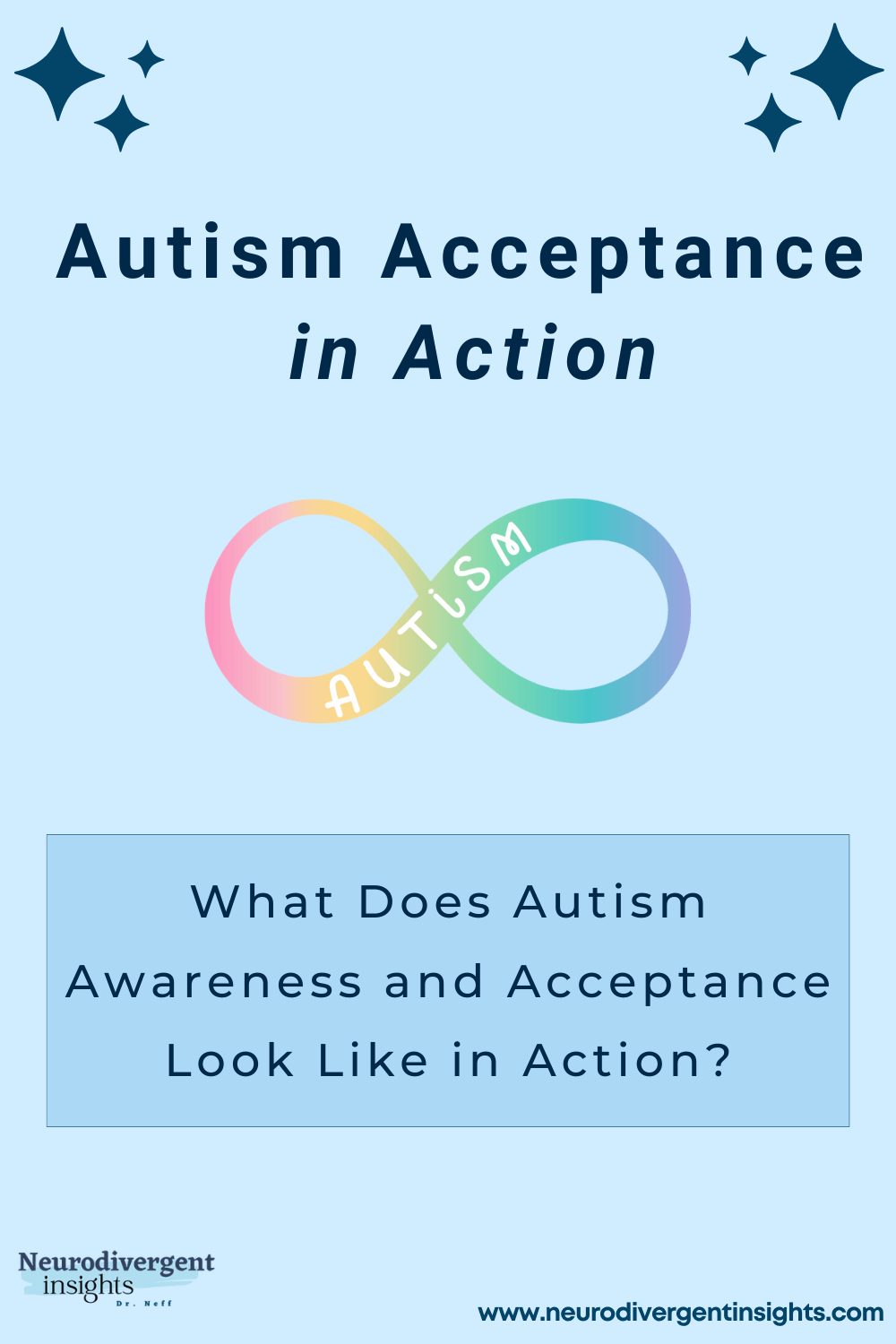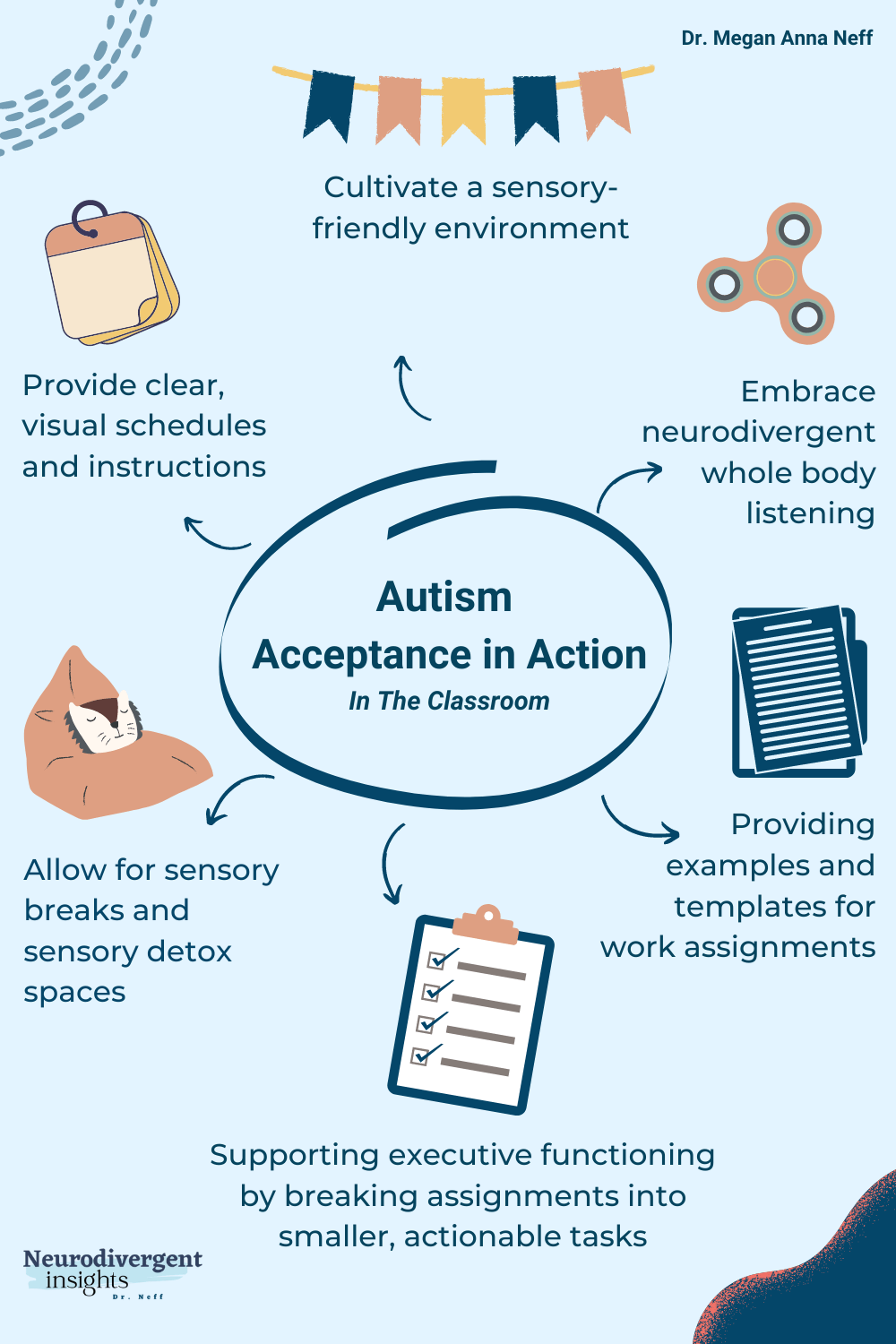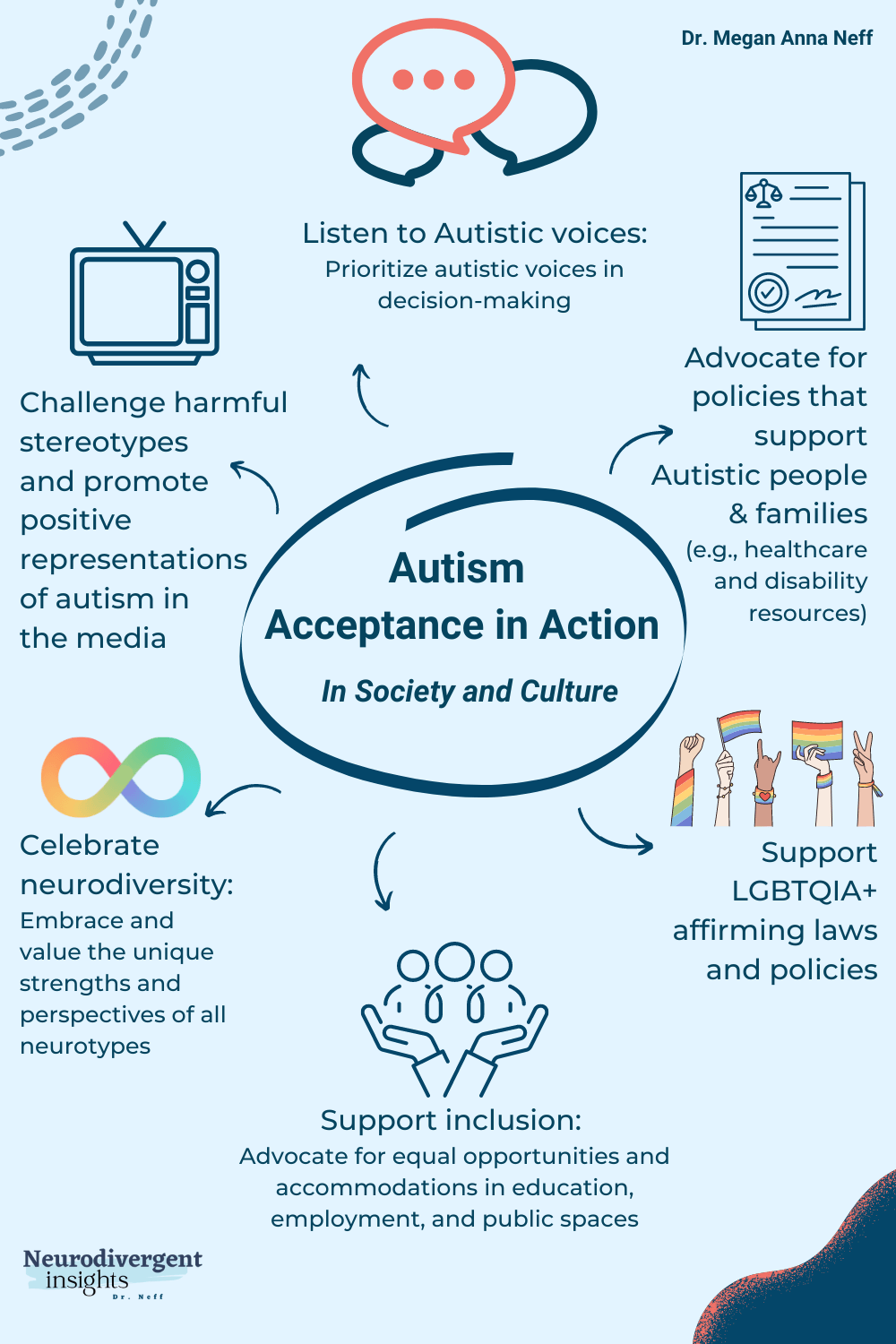
Disclosure: This post contains affiliate links. If you purchase through these links, I will earn a small commission at no extra cost to you.
April marks Autism Awareness and Acceptance Month. Autism Acceptance Month is a time to celebrate the culture and diversity of the Autistic community and promote acceptance and understanding. “Autism acceptance” and “autism awareness” are big words. As an Autistic person, big words don’t mean much to me until I break them down into actionable, concrete steps. Last year, I did this by creating a series of Autism Awareness infographics for underrepresented groups (women, BIPOC, trans). This year I thought I’d break down the idea of autism awareness and acceptance by looking at autism acceptance in action.
Acceptance sounds nice and fluffy. But what does autism acceptance actually mean? And what does autism acceptance look like in action? It’s a term we hear a lot these days, and while it’s easy to promote autism acceptance messages, it is more complicated to implement autism acceptance in structural and practical ways.
In this blog series, I want to explore concrete ways individuals can practice autism acceptance in different contexts. In this post, I’ll share some examples of what it means to embrace and practice autism acceptance. This is by no means an exhaustive list, and there is a wide variance of support needs within the Autistic community. But here are some practical steps to incorporate autism acceptance into action.
Autism Acceptance in Families
Arguably the most critical acceptance starts in the family. Families play an integral role in the well-being of Autistic individuals. How a family does or does not accommodate, support, and accept autism will significantly impact the person’s developing sense of self and worth.
Autism acceptance within the family involves recognizing and embracing neurodiversity and honoring each individual’s needs and strengths. This includes creating a safe and supportive home environment that allows for sensory regulation, neurodivergent communication, and connection. By embracing and celebrating neurodiversity within the family unit, families can help empower, encourage the integration of Autistic identity, and foster a healthy sense of worth and self-esteem. While not an exhaustive list, here are some practices for creating an inclusive and supportive home environment for autistic individuals and their families.
Ideas for Autism Acceptance in Families:
 ✦ Normalize stimming (self-stimulatory behavior, such as rocking or hand-flapping), which helps regulate our emotions and focus
✦ Normalize stimming (self-stimulatory behavior, such as rocking or hand-flapping), which helps regulate our emotions and focus
✦ Develop a sensory lens and address clashing sensory needs
✦ Create a sensory-safe room or place where the family member can go to sensory-detox
✦ Celebrate and support your loved one’s interests and lead with object-based conversations over social-based conversations
✦ Create a predictable routine and environment (Our family has used this huge whiteboard for years to map out the day/weekend and week routines visually)
✦ Get curious and explore! Learn about different neurologies (how different neurotypes process information and how needs may differ)
✦ Support LGBTQIA+ identities (given the high rate of overlap between the autism spectrum, gender spectrum, and sexual diversity-supporting, exploration and integration of LGBTQIA+ identities often plays an important role in supporting the identity integration of the family member)
✦ Explore your own possible neurodivergence! Parents often worry it is “selfish” to explore their neurotype in the aftermath of a child’s diagnosis. But this is one of the most powerful things you can do. It may help you to connect with your child, understand them, and for your child to feel understood by a parent in the household.
Autism Acceptance in the Classroom
In the Classroom, Autistic students may have different learning styles and needs compared to their neurotypical peers. Embracing autism acceptance in the classroom means creating an environment that respects and accommodates multiple neurotypes.
Ideas for Autism Acceptance in the Classroom:
 ✦ Normalize stimming (self-stimulatory behavior, such as rocking or hand-flapping), which helps us regulate our emotions and focus
✦ Normalize stimming (self-stimulatory behavior, such as rocking or hand-flapping), which helps us regulate our emotions and focus
✦ Embrace whole-body (neurodivergent) listening. Whole-body listening for neurodivergent people may involve fidgeting, moving our bodies, doodling, or more
✦ Keep visual clutter to a minimum. For those of us with visual sensitivities, visually chaotic environments can cause cognitive and sensory overload
✦ Encourage sensory regulation by providing sensory breaks and sensory detox areas
✦ Accommodate interoception differences. Create a system that allows students to urgently use the bathroom when needed (vs. being excused)
✦ Provide clear, direct instructions and provide examples and templates when possible
✦ Providing visual aids and written instructions to help with executive functioning difficulties
✦ Allowing for sensory breaks or accommodations such as noise-canceling headphones or fidget toys
✦ Encouraging and incorporating students’ special interests
✦ Creating a quiet or low-stimulation area for the student to retreat to if needed
✦ Being mindful of sensory sensitivities when planning classroom activities or events
✦ Support executive functioning by breaking large projects down into smaller tasks and actionable steps
✦ Provide clear, visual schedules and instructions
Resource: Check out everyday regulation for the Whole Body Listening (Neurodivergent edition) poster and other great resources.
Autism Acceptance in Therapy
Many Autistic people seek therapy to help them cope with the challenges of being Autistic in a non-Autistic world. Additionally, Autistic individuals may seek therapy to address co-occurring conditions such as anxiety, depression, or PTSD. Unfortunately, many therapists are not trained to work with Autistic clients in a way that respects their differences. They may see autism as a problem that needs to be fixed or cured rather than a neurodivergent identity that is valuable in its own right.
Additionally, therapy sessions can sometimes be overwhelming or stressful for Autistic individuals due to sensory overload or difficulty navigating the allistic social-emotional communication methods often used in therapy.
Autism Acceptance in therapy means recognizing that Autistic people have unique strengths and challenges and that therapy should be tailored to their specific needs. It means understanding that the goal of therapy is not to “cure” Autistic people but to support them in achieving their goals and living fulfilling lives.
Embracing autism acceptance in therapy means adapting our therapeutic approach by accommodating autistic needs. Here are some practices that can bring autism acceptance into action in the clinician’s office:
Ideas for Autism Acceptance in Therapy:
✦ Consider autism as an identity, not a disorder. This may involve things such as:
 Using identity-first language (or the preferred language of your client)
Using identity-first language (or the preferred language of your client)
Ensuring you’re taking the client’s lead in establishing goals of treatment. Be mindful of treatment goals that are trying to make the person more allistic
✦ Encourage and support sensory regulation and sensory safety. This may involve things such as:
- Providing a calm and sensory-regulating therapy environment
- Encourage stimming and sensory exploration in sessions
- Helping your client explore their sensory preferences and triggers and developing a sensory safety plan
✦ Reducing demands for social-based conversations and allistic social-communication norms (eye contact, “how are you,” “tell me about yourself”). Note these are experienced as incoming sensory demands by many of us
✦ Accommodate interoception differences and support interoception-building exercises. This may look like this:
Considering the impact of interoception awareness on emotional regulation skills. If they are struggling with emotion regulation, start with interoception-builder activities
✦ Consider alternative communication methods
Consider chat, writing, use of AAC, and other devices when speaking becomes difficult for clients
Consider using music, art, and photos to discuss the client’s emotional words (vs. relying solely on emotion-based vocabulary and words)
✦ Educate yourself on non-stereotypical presentations and accurately diagnose women, BIPOC, genderqueer, and other non-stereotypical presenters
✦ Be an advocate outside of the therapy chair. Write accommodation letters, educate parents, and support the client in developing self-advocacy skills
✦ Embrace Neurodivergent Communication Style. This can look like:
Connecting over special interests
Embracing divergent and non-linear conversation
Embracing context-heavy communication style (i.e., you ask a question, the client describes the context vs. provides a top-down synthesized answer)
Reconsider self-disclosure-understanding the context and mind of the other helps creates psychological safety for many Autistic people. It also helps with perspective seeking (and many of us assume people are thinking more negatively about us than they actually are, so it also serves to provide helpful reality testing!)
✦ Consider neurodivergent trauma. Autistic people are vulnerable to traumas that are not classically thought of as “trauma” within the mental health world—for example, sensory trauma, social trauma, and more. The impact of trauma also impacts our nervous systems more intensely. So support nervous system regulation and healing from neurodivergent trauma
Resource: Several of these concepts were influenced by the work of Dr. Joel Schwartz. For a great podcast on how to be a neurodivergent-affirming therapist, check out his interview with Patrick on the All Things Private Practice Podcast. Additionally, I recommend checking out books like The Adult Autism Assessment Handbook and Is This Autism? A Companion Guide for Diagnosing, both of which offer valuable information on autism assessment and diagnosis from an affirmative framework. If you’re looking for more resources, my clinician membership area offers a range of helpful workbooks and access to a private community where you can ask questions and connect with other clinicians.
Autism Acceptance in Medical Settings
Navigating medical settings can be a daunting experience for anyone. However, for Autistic individuals, it can be an incredibly challenging experience. We often experience medical visits as confusing, sensory overloading, and pathologizing.
The medical field has traditionally been ill-equipped to accommodate the needs of Autistic individuals. In addition, misunderstandings about autism and associated behaviors can lead to misdiagnosis or inadequate treatment.
Complicating matters, many of us have chronic and complex medical conditions! Therefore, the importance of autism acceptance in medical settings cannot be overstated. By understanding the needs and experiences of Autistic individuals, we can create a more accessible and inclusive healthcare system. Here are some practical ways to embrace autism acceptance in medical settings:
Ideas for Autism Acceptance in Medical Settings:
 ✦ Offer options for communication (e.g., written forms, visual aids, communication apps)
✦ Offer options for communication (e.g., written forms, visual aids, communication apps)
✦ Allow for longer appointment times if needed
✦ Offer sensory-friendly waiting areas and exam rooms (e.g., avoiding strong scents and encouraging the use of fidget toys)
✦ Allow patients to voice record visits so they can relisten to it when not overstimulated (also helpful for ADHDers)
✦ Use visual aids to prepare for medical procedures
✦ Consider and support commonly co-occurring conditions
✦ Provide clear, straightforward communication (Provide written materials to supplement verbal communication)
✦ Provide gender-affirming care that considers a person’s sensory and executive functioning needs
Autism Acceptance in The Workplace
Autistic people have valuable skills and strengths that can contribute to the workplace. However, these skills are often not fully materialized due to sensory and communication barriers we experience in the workplace.
Embracing autism acceptance in the workplace means creating a culture that respects and values a diversity of brain styles. This could involve providing sensory-friendly workspaces, flexible schedules, or alternative communication methods to accommodate different work styles and needs.
Ideas for Autism Acceptance in the Workplace:
 ✦ Offer accommodations such as noise-canceling headphones
✦ Offer accommodations such as noise-canceling headphones
✦ Include regular education about neurodiversity in the workplace
✦ Celebrate and utilize employee strengths and interests
✦ Offer autism-specific training for supervisors and managers
✦ Provide clear communication and expectations
✦ Offer flexible work environments and work hours when possible
✦ Create multiple options for communication
✦ Allow for sensory breaks and alternative workspace options
✦ Offering a mentor to new employees for guidance in navigating work culture
✦ When possible, provide advanced notice of schedule changes
Resource: Mentra is an excellent resource for neurodivergent people seeking employment. Mentra is a neurodivergent-friendly work platform that intelligently matches neurodiverse individuals with employers that value their strengths (created by and for neurodivergent people).
Autism Acceptance in Society
Autistic people have a long history of being excluded and marginalized from society. Autistic people face societal barriers and stigma due to a lack of understanding and acceptance of our neurological differences. Embracing autism acceptance in society means challenging these stereotypes and promoting a culture of inclusion and understanding. It means embracing diverse neurotypes as a valid way of being in the world.
This could involve advocating for policy changes that support the rights and needs of Autistic individuals, promoting representation of Autistic voices in media and public spaces, or simply educating others about the diversity and benefits of living in a neurodivergent world. It could also include accommodations for sensory needs in public spaces, education and employment opportunities that value neurodiversity, and medical care that respects the autonomy and agency of the Autistic individual.
It also means challenging the harmful stereotypes and myths about autism that still persist, such as the idea that Autistic people lack empathy or are unable to form meaningful relationships. By recognizing and celebrating the diversity of autism, we can create a society that is truly inclusive and accepting of neurodiversity.
 Ideas for Autism Acceptance in Society:
Ideas for Autism Acceptance in Society:
✦ Support LGBTQIA+ affirming laws and policies
✦ Celebrate neurodiversity: Embrace and value the unique strengths and perspectives of all neurotypes
✦ Challenge harmful stereotypes and promote positive representations of autism in the media
✦ Listen to Autistic voices: Prioritize autistic voices in decision-making
✦ Support inclusion: advocate for equal opportunities and accommodations in education, employment, and public spaces
✦ Advocate for policies that support Autistic people & families (e.g., healthcare and disability resources)
Resource: ASAN is a great resource for getting involved in Autistic self-advocacy and advocacy initiatives.
Autism Acceptance in Research
Autism acceptance extends to all areas of society, including research. Historically, autism research has been allistic-centered. Autistic individuals have largely been excluded or marginalized from research, with little consideration given to their perspectives and experiences.
Thankfully there is a growing movement towards including Autistic individuals in research in meaningful ways, focusing on prioritizing Autistic voices. There is also emerging research shifting from trying to “fix” and “stop” autism to focusing more on promoting Autistic well-being.
Following are some practical actions that researchers and the research community can implement to work towards greater autism acceptance.
Ideas for Autism Acceptance in Research:
 ✦Increase accessibility of research instruments to underrepresented groups such as groups with lower socio-economic access, non-speaking Autistic people, BIPOC and genderqueer people, and Autistic people from underrepresented cultures
✦Increase accessibility of research instruments to underrepresented groups such as groups with lower socio-economic access, non-speaking Autistic people, BIPOC and genderqueer people, and Autistic people from underrepresented cultures
✦Consider Intersectionality in research
✦Avoid pathologizing or stigmatizing language in research publications and discussions
✦Prioritize research that addresses the needs and experiences of Autistic individuals
✦Listen to Autistic voices. Involve Autistic individuals in research design and implementation
✦Disseminate research findings to the broader Autistic community in accessible formats
Resource: An example of a research journal doing an excellent job is Autism in Adulthood. They also provide open access to their journals.
Conclusion: Autism Awareness and Acceptance
Autism awareness and acceptance are not just buzzwords or trendy slogans. It’s not a checkbox we complete once a year. It involves ongoing efforts to address internalized and structural ableism and build a more inclusive society. Embracing autism acceptance also means more than just acknowledging the existence of autism. It is a mindset and a way of living that values and affirms the dignity, autonomy, and contributions of Autistic individuals.
Autism acceptance in action means actively promoting understanding, accommodation, and inclusion for Autistic people in all areas of life. From family homes to classrooms to workplaces to public spaces, we can all take practical steps to put autism acceptance into action and create a more affirming world for all neurotypes. By putting autism acceptance into action, we can create a world that truly celebrates and values neurodiversity.








